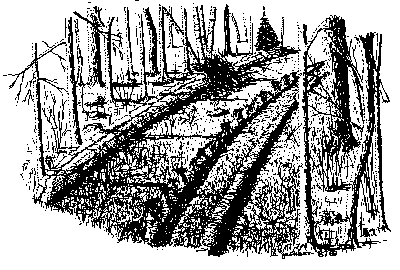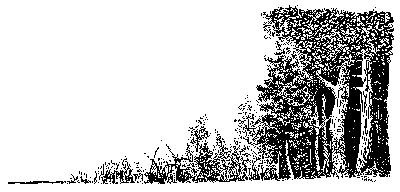Daylighting Roads and Trails to Create Edge
Daylighting refers to the cutting and release of vegetation along areas within forested habitat for the purpose of increasing sunlight on the forest floor. This encourages growth of shrubs and herbaceous vegetation. Daylighting is primarily used to open up the edge of trails, roads and fields.
In order to understand wildlife benefits that result from daylighting, the edge concept must be explained. Edge is the place where plant communities meet, or where various successional stages within plant communities come together. The area influenced by this transition is called an ecotone. Edges and their ecotones are typically richer in wildlife than the adjoining plant communities because they provide more of the needs required by wildlife than a single vegetative or community type. Ideally, brush and grass form a narrow border along daylighted areas. These vital openings provide an abundant food source of various seeds and insects for wildlife. Edges are also used by wildlife as travel lanes.
Enhancement Practices
Establishing edge along roads and trails is best accomplished when the actual construction of the road or trail takes place, since equipment is at hand. If construction has long since been completed, cordwood cutting would be the best method for creating edge habitat.
Vegetation should not be removed from roads or trails where the existence of excessive slopes or water courses may cause erosion problems.
Generally speaking, the following enhancement practices will meet the requirements for establishing an edge effect:
- Remove all woody vegetation within 10 feet of both sides of a road or trail. Of this 10 feet, five feet (closest to the road or trail center) should have stumps and rocks removed, if possible. Clear the ground and break up the soil so that grasses and forbs can be planted and maintained.
- Remove approximately 50 percent of the trees on both sides of the road or trail extending 25 to 30 feet into the forest. This will create a transition of vegetation from grass/forb to seedling/sapling to open forest to forest.
Maintaining a daylight area is an important concept in habitat management. This area must be regularly maintained or else wildlife species richness will decrease as the cut-over area reverts to a less desirable vegetative stage.
- Every three to five years, the five-foot-wide grass/forb areas should be brush mowed. This helps curtail and retard the encroachment of unwanted woody vegetation.
- Every 12 to 15 years, the outer areas closest to the forest land border should be cut to allow additional sunlight for stimulation of understory vegetation.
- In areas where it would not be aesthetically pleasing to practice daylighting, the total length of a road or trail could be broken up into smaller release sites.
Additional wildlife enhancement practices may include creating brush piles along the edge of forested land and erecting bird nest boxes along the edge of grass and brush openings.
Glossary
Forb -- any herbaceous plant species other than those in the grass, sedge and rush families; fleshy leaved plants.
Herbaceous -- a plant that grows from seeds or perennial roots rather than from woody, above-ground parts.
Succession -- the changes in vegetation and in animal life that take place as the plant community evolves from bare ground to the climax stage (e.g., old growth forest).
Successional stage -- a stage or recognizable condition of a plant community which occurs during its development from bare ground to climax.
 The Technical Assistance
Informational Series is 75 percent funded by Federal Aid to Wildlife Restoration -
Pittman-Robertson (P-R) Program. The P-R Program provides funding through an excise tax on
the sale of sporting firearms, ammunition, and archery equipment. The remaining 25 percent
of the funding is matched by the Connecticut Wildlife Division. (rev. 12/99)
The Technical Assistance
Informational Series is 75 percent funded by Federal Aid to Wildlife Restoration -
Pittman-Robertson (P-R) Program. The P-R Program provides funding through an excise tax on
the sale of sporting firearms, ammunition, and archery equipment. The remaining 25 percent
of the funding is matched by the Connecticut Wildlife Division. (rev. 12/99)

